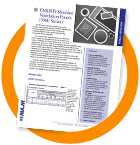How many times have you wished you had one material – a “go to” choice for easier product design and engineering in EMI/RFI shielding applications – that offers:
- Superior EMI attenuation;
- Multiple materials available including monel and ferrous;
- Production-friendly capabilities for the prototype or large production runs;
- And is able to be shaped into 1000’s of forms for hundreds of uses?
That product is found in MAJR Products’ knitted wire mesh.
What is MAJR’s Knitted Wire Mesh?
The vast usability of the product lies in the material’s design. Knitted wire mesh is composed of .002 to .004 diameter wires which are woven into a fabric-type material resembling a tube. This can be compressed to make superior conductivity along its length and therefore create a path for stray EMI/RFI signals to be carried to a ground or reflected away from sensitive electronics.
During the manufacturing process, these loops or tubes can be knitted over themselves and run through a die to create a wire mesh cord of various diameters. It can also be pressed and cut into different shapes. It’s this engineering and production process that forms the basis for flexibility in many signal attenuation and hardened enclosure applications.
Flexibility in EMI/RFI Attenuation Applications
Because of its ability to be compressed, drawn through multiple dies or shaped into appropriate configurations – plus superior signal reflection or direction – MAJR’s knitted wire mesh is perfect for a number of places within civilian and military projects.
- Knitted wire mesh tape is a double-layered tape-like use of this product that is normally used in interior applications for electromagnetic field attenuation. Because of its high physical strength, lightweight and easy conformability it can fit within difficult spaces, making your product production simpler. It can be knitted over a conductor to shield wires or harnesses from radiated signals and differential modes.
- EMI/RFI wire mesh washers are compressed and shaped to appropriate thickness or size through the use of special dies. By using different weights of the knitted material, densities can vary and be made suitable for multiple applications. Those with a metal density of 10-20% will also “flow” under minimal compression to fill gaps or seams. These provide superior grounding capabilities for attaching a hatch, door or vent to a Faraday cage.
- EMR/RFI gaskets using knitted wire mesh provide electromagnetic shielding around vents or doors. They can be found in plentiful sizes and shapes, are often custom made, and come with or without a pressure sensitive adhesive (PSA) for quick installation. They can also be manufactured with or without an elastomeric core (silicone, neoprene or Poron) to offer use in multiple environmental conditions while standing up to chemicals, dust and weather. When an elastomeric core is added the combination can provide more “spring back” on doors and hatches, forming an easier and better seal versus using the metal wire mesh itself. Wire mesh gaskets are also commonly used with vents, such as MAJR’s honeycomb ventilation panels.
As you can see, it is the engineering behind the knitted wire mesh that allows it to be made into multiple products for stray noise attenuation, all while remaining light, flexible and durable. Between tapes, washers and gaskets there are literally 1000’s of possibilities for hundreds of applications.
Selecting the Right Knitted Wire Mesh Type for Your Civilian or Military Products
With so many applications and uses, however, it becomes imperative that engineers take into consideration several points. The first is galvanic reaction.
Metals of dissimilar types can be prone to galvanic corrosion. Misuse is commonly seen, for example, between the gasket mounting surface and the wire mesh. Two unfriendly metals will, over time, create a battery-like effect complete with voltage. This causes a breakdown in conductivity or shielding properties and leads to EMI/RFI attenuation failure. For that reason MAJR Products’ knitted wire mesh is manufactured in a variety of metals; tin plated steel, silver plated brass, monel and aluminum. Selecting the correct metal for your wire mesh becomes critical to the lifespan of your enclosure.
Size, density and thickness of the needed material, needed attenuation levels, the type of elastomeric core (if appropriate), the standards to meet for civilian or military use and a decision about the use of PSAs for quick production runs; these are additional things to consider that are equally important.
Call MAJR Products
Although flexible in nature and application, knitted wire mesh is not a one-size-fits-all product. MAJR’s engineers, specialists in civilian and military hardened enclosures, are available to help you select the right material for your knitted wire mesh tapes, washers and gaskets. Give the experts at MAJR Products a call, at 877-625-6025, to get your questions answered and a quote at the same time.

